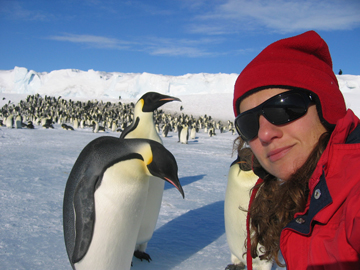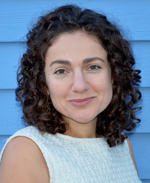
Asked in first grade what she wanted to be when she grew up, Jessica Meir drew a picture of herself as an astronaut. The youngest of five children, Meir grew up in Caribou, Maine, later pursuing a career in biology interspersed with space science, skydiving and scuba diving, but what she always wanted to be was an astronaut.
“This is something I’ve thought about since I was 5 years old,” Meir said in an interview this week after NASA’s announcement. “It was always in the back of my mind, but it’s so hard to believe it came true.”
Now she will have a chance to live her dream. An HMS assistant professor of anesthesia at Massachusetts General Hospital, Meir has been selected as one of eight members of NASA’s 2013 Astronaut Candidate Class.
Between Maine and Mass General, she seized every opportunity to train in space science. Meir’s deep interest in biology has taken her to the ends of the Earth to study how animals thrive under low-oxygen conditions that would fell the hardiest humans. On scientific expeditions to Antarctica during graduate school, she studied the diving physiology of emperor penguins as they plunged deep beneath the sea ice. Emperor penguins can remain submerged for almost 30 minutes on a single breath; elephant seals, which Meir studied on the beaches of California, can remain underwater for an astonishing two hours.
 To study how bar-headed geese can fly above the altitude-sickness-inducing Himalayas, Meir imprinted newly hatched birds, becoming a modern-day Mother Goose. She trained them to fly in a wind tunnel, simulating conditions at the roof of the world, while measuring various aspects of their physiology.
To study how bar-headed geese can fly above the altitude-sickness-inducing Himalayas, Meir imprinted newly hatched birds, becoming a modern-day Mother Goose. She trained them to fly in a wind tunnel, simulating conditions at the roof of the world, while measuring various aspects of their physiology.
Her curiosity about oxygen depletion in extreme conditions, studied through the lens of comparative physiology, eventually brought her to Warren Zapol’s lab at Mass General last fall. Zapol is the HMS Reginald Jenney Professor of Anaesthesia.
Meir fell in love with biology during her freshman year at Brown University, completing a comprehensive training program in space and the life sciences at the Kennedy Space Center in Florida the following summer. Before her senior year, she became acquainted with an aircraft that subjects passengers to reduced gravity conditions—also known as the “vomit comet”—where she had the opportunity to do experiments with new forms of tissue adhesive for healing wounds.
After graduation, she attended the International Space University in Strasbourg, France, where she mastered interdisciplinary topics, from orbital mechanics to space policy.
Meir then worked for three years at NASA’s Johnson Space Center in Texas, where she was an experiment support scientist, acting as a liaison between principal investigators and the space agency. She also went on an underwater habitat mission off Key Largo, Fla., with the same goal of studying human physiology through an earthbound analog to space flight.
At the Scripps Institution of Oceanography (UC San Diego) in California, she earned her doctorate, writing her dissertation on deep-diving animals and how they manage their oxygen stores. Her post-doctoral position at the University of British Columbia in Vancouver allowed her to study the remarkable bar-headed geese.
“The common thread is understanding the physiology of animals that live in extreme environments,” she said.
Although excited about the Zapol lab’s opportunity to learn more about such animals from the deep-diving Weddell seal’s genome (recently sequenced by scientists at the Broad Institute), she will be leaving soon. Starting in August, there will be two years of training for the new astronaut candidates, followed by more years of mission-specific preparation.
“These new space explorers asked to join NASA because they know we’re doing big, bold things here—developing missions to go farther into space than ever before,” NASA administrator Charles Bolden said in a statement on Monday.
“They’re excited about the science we’re doing on the International Space Station and … they’re ready to help lead the first human mission to an asteroid and then on to Mars,” he said.
Looking back, Meir is grateful to her teachers and mentors, who saw her passion as a young girl and helped guide her quest to become a scientist.
“I always had a dream of being in space and seeing the Earth from up above,” she said. “From people I know who have seen it, I know it’s a life-changing moment to look back at our planet.”


